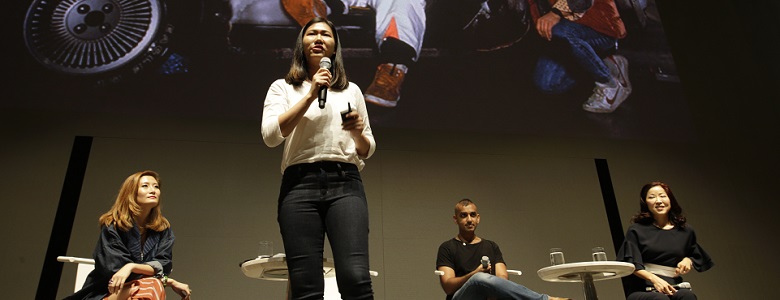Using artificial intelligence to make real-world connections
- Artificial intelligence (AI) is no longer an experiment confined to the lab; it’s permeating our everyday lives
- AI’s potential for disruption stems not just from the technology alone, but also from how it is being used to connect people and combine disparate ideas
- The technology is even more disruptive if it is made accessible to anyone who needs it, including people in developing countries
Last year, when textile designer Ms Elaine Ng was asked by the Hong Kong Design Centre to create an exhibit commemorating the 20th anniversary of Hong Kong’s return to China, she discovered to her horror that she had only six weeks to finish the project.
Deciding to enlist the help of robots, she approached a robotics expert, who was sceptical at first. “They had no idea what I was talking about,” said Ms Ng, founder of Hong Kong-based textile design company The Fabrick Lab.
But by the end of the project, her abstract textile-covered sculptures had come alive with sensors and robotic arms that responded to visitors when they waved at or talked to the exhibit. Even better, the robotics expert wanted to start a new project to turn the robots into educational kits.
“I was really happy that he went from the point of not wanting to participate in the project to having new ideas… this is the whole point of pushing boundaries,” she told the audience at the ‘AI and the Human Connection’ panel discussion at the Festival of Disruptors, held in Singapore on 6 November 2017. The inaugural festival was organised by local crowdfunding site Gofiee and Sydney-based media owner Sundance Company, with GovTech as a supporter.
The panel, which also consisted of Mr Abhilash Murthy, the mastermind behind Singapore’s Bus Uncle chatbot, and Ms Annabelle Kwok, founder of Singapore AI company SmartCow, revealed that the disruptive potential of artificial intelligence (AI) does not stem from the technology alone. Whether it is artwork that interacts with humans, being a fun companion in one’s everyday life, or bringing medical services to remote communities, this potential also comes from how the technology is being used to combine disparate ideas to achieve bigger goals.
When your bot goes viral
The communion between human and robot has already permeated our everyday life. Recently, Bus Uncle, a chatbot that tells anxious commuters when their bus will arrive, while at the same time cracking jokes in Singlish, went viral in Singapore.
Mr Murthy, the bot’s creator, said the idea came to him when he was waiting for a bus along Orchard Road. “I was thinking about how long I had to wait for the bus. It was a small simple question in my head, and I wished I could just ask someone.” Typically, he said, people check the electronic boards at the bus stop or consult bus apps, but “that just felt too complex”.
The chatbot, which converses with users on Facebook Messenger, now receives almost a million messages a month. While most chatbots follow a linear decision-making process in which the user makes choices based on a fixed sequence of questions, Bus Uncle can take one’s location or desired bus number as a conversation starter, said Mr Murthy.
“I realised that a lot of people started using Bus Uncle because they enjoyed speaking to him—there’s a human connection,” said Mr Murthy, noting that there are now more people using messaging apps like WhatsApp, Messenger and WeChat, where they interact with friends in real time, than there are using social networks like Facebook and Twitter.
Mr Murthy sees a future in which natural language processing will become the norm in apps—where answers will be delivered in direct response to a user’s questions rather than through menus and buttons. He also envisions chatbots that talk to one another to satisfy a user’s multiple requests, such as for a meal or a taxi.
Saving lives with AI
Although the AI developed by Ms Kwok’s company SmartCow does not crack jokes, you may one day thank it for saving your life.
SmartCow is working with a major airport on a system to automatically analyse, from video footage, the appearance and behaviour of people, down to the kind of bag they are carrying and whom they are walking with. While this may sound creepy, Ms Kwok said the technology could be very useful—for example, it could enable rapid contact tracing in the event of a virus outbreak, or flag suspicious behaviour for rapid response by security services. “We’re turning normal photos and video footage into something smart… and it could potentially ward off terrorist attacks.”
AI can also make a difference to people in developing countries, said Ms Kwok. SmartCow is providing one of its products, a portable supercomputer that runs on eight AA-sized batteries, to a German company developing AI software to detect malaria in blood samples from people living in remote villages in the Philippines.
Normally, health workers have to transport blood samples to a lab for testing, which takes weeks and makes early detection and treatment impossible. With the new device, the entire village could be tested for malaria on the spot. If it works, there are plans to deploy it in Africa and adapt it for other diseases, such as tuberculosis.
“Think about how much more disruptive something can be if it’s accessible to the people who need it most,” said Ms Kwok.
https://www.tech.gov.sg/media/technews/using-artificial-intelligence-to-make-real-world-connections

